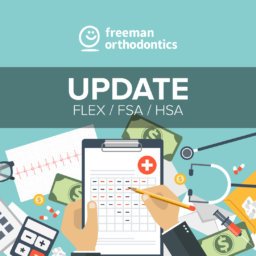You may have heard people say, “I have TMJ,” but what exactly do they mean?
Usually, they’re referring to pain in the Temporomandibular Joint (TMJ), which is a common dental issue. Chronic pain in the jaw joint is called Temporomandibular Disorder (TMD), though many people simply refer to it as TMJ.
TMD can be painful, but it’s possible to relieve that pain through orthodontics. Braces can realign your teeth and reduce TMJ pain and inflammation. We’ll explain the symptoms and tell you how Freeman Orthodontics can help.
What Is TMJ/TMD?
The Temporomandibular Joint is the connection between your skull and your lower jaw. It’s a hinge joint, meaning it swings up and down for talking, chewing, etc. The joint is designed to swing freely when the jaw is lined up properly.
TMD occurs when the joint becomes inflamed. There are several reasons why this happens, including:
- Misaligned bite
- Missing teeth
- Habitual teeth grinding
- Joint trauma, such as from an accident
- Arthritis
- Joint erosion from years of misalignment
- Joint or jaw birth abnormalities
Jaw pain and discomfort are the most common symptoms of TMD. Other symptoms include:
- Pain when chewing
- Difficulty chewing
- Neck or face pain
- Earaches
- Headaches
- Swelling on the side of the face
- Popping, clicking, or grating of the joint when opening or chewing
- Sensitive teeth
How Braces Can Help
For the most severe cases, surgery may be required to correct TMJ disorders, particularly if they’re caused by trauma, birth abnormalities, or arthritis.
For many patients, braces or clear aligners can reduce or eliminate TMJ pain.
Your teeth and jaws are designed to bite and chew a certain way. When your teeth are correctly aligned, you’re able to chew your food efficiently without forcing the jaw to move in ways it wasn’t designed to do.
Misaligned teeth make it harder to chew your food properly. That means the jaw must make moves it wasn’t designed to do, such as more side-to-side movement than normal. This extended movement can wear the joint down over time. That causes inflammation in the tissue in and around the joint, which becomes painful over time.
Prolonged misalignment can wear down the joint, which could mean surgery will be needed later.
Braces and clear aligners put your teeth back where they belong, making chewing easier and relieving that excess jaw pressure that damages the joint.
Your orthodontist can also help with TMJ pain due to chronic teeth grinding. There are orthodontic appliances available to prevent teeth grinding. Ask Dr. Freeman about your treatment options!
What Works for You
The best way to find out how to alleviate your TMJ pain is to speak with an orthodontist in San Jose. In The Bay area, you can request an evaluation with Freeman Orthodontics to get started. We will examine your teeth and jaw and let you know what we can do to help. Let us see what we can do to get rid of your TMJ pain!

























